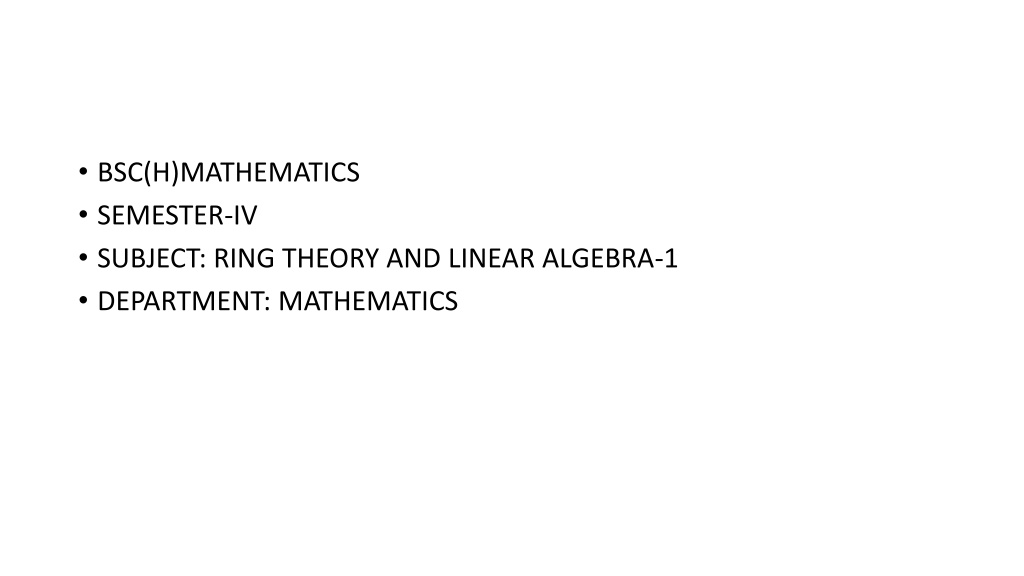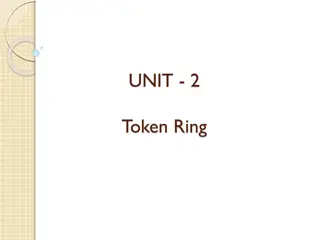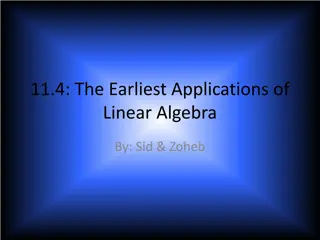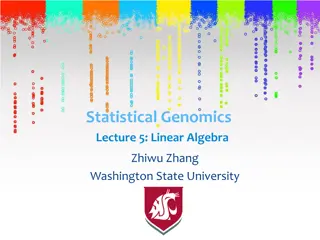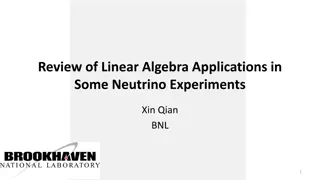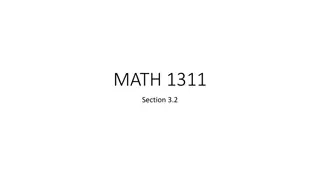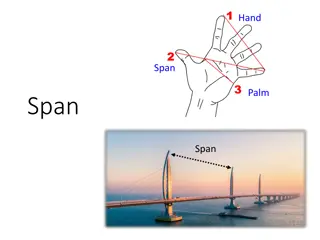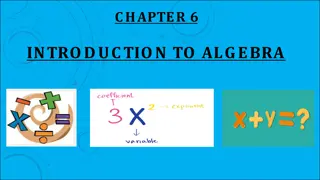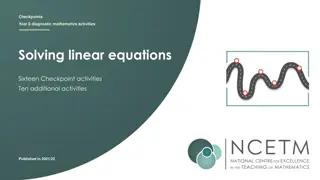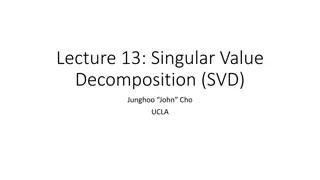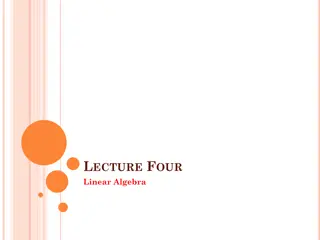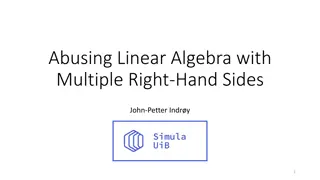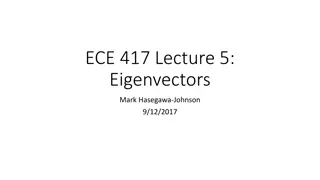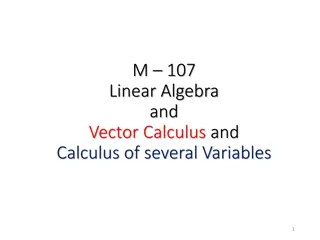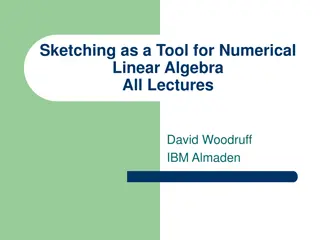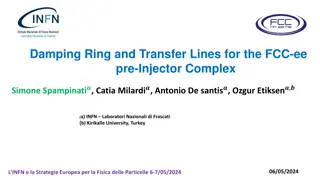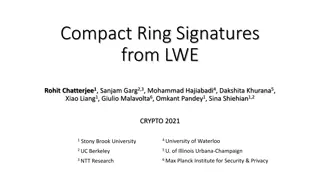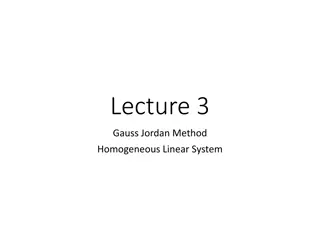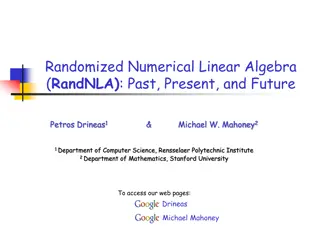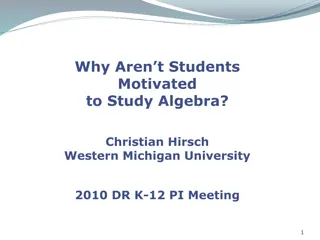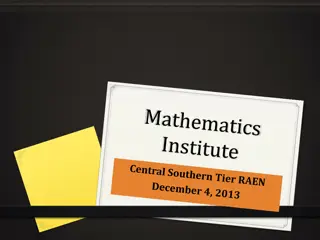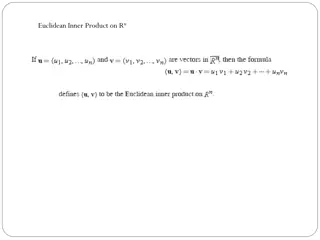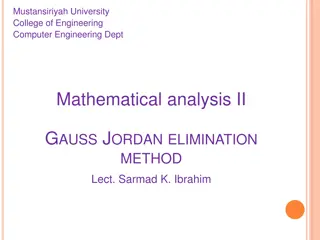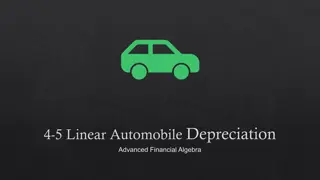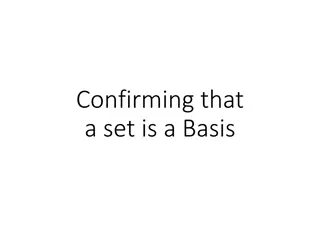Understanding Ring Theory and Linear Algebra in BSc (H) Mathematics
Explore the concepts of ring theory and linear algebra through examples and proofs in the context of BSc (H) Mathematics, Semester-IV. Discover the foundational principles behind abstract algebra and how they apply to mathematical structures.
Download Presentation

Please find below an Image/Link to download the presentation.
The content on the website is provided AS IS for your information and personal use only. It may not be sold, licensed, or shared on other websites without obtaining consent from the author. Download presentation by click this link. If you encounter any issues during the download, it is possible that the publisher has removed the file from their server.
E N D
Presentation Transcript
BSC(H)MATHEMATICS SEMESTER-IV SUBJECT: RING THEORY AND LINEAR ALGEBRA-1 DEPARTMENT: MATHEMATICS
CHAPTER-14 CREDIT/REFERENCE: J. GALLIAN, 4THEDITION CONTEMPORARY ABSTRUCT ALGEBRA
Example 10 Let ?1 ?3 ?1 ?3 ?2 ?4:?? ? ?2 ?4 ? ?= 16 ? = ? = :???? ???? Show that
?2 ?4:?? ? ?2 ?4 ?2 ?4+ ? ?? ? 2?1+ ?1 2?2+ ?2 2?3+ ?3 2?4+ ?4 ?1 ?3 ?1 ?3 ?1 ?3 ? = ? = :???? ???? ? is ideal of ? (verify) ? ?= + ?:??,?? ?,??= 0,1 = ?1 ?3 ?2 ?4 +2?1 2?3 + ? ??= 0 ?? 1 2?2 2?4 + ? ??,?? ?,??= 0,1 = ?1 ?3 ?2 ?4 = ? ?= 16 Note :
Example 11 ?[?] 2 ? ?5
?[?] 2 ? ?5 To show : ? = ? = ? + ?? + 2 ? :? ,? (1) Since 2 ? + 2 ? = 0 + 2 ? ( ? + ? = ???? ? ?) 2 ? can be treated at 0, i.e. 2 = ? and 22= 1 ?.?.5 = 0 (3) ? + ?? = ? + 2? = ?(???) which is an integer (2) From (1) & (2)
? = ? + 2 ? :? Since 5 = 0, ? = ? + 5? = ? where ? = 0 ,1,2 ,3 ,4 ? = ? + 2 ? ? = 0 ,1 ,2 ,3,4 = 2 ? ,1 + 2 ? ,2 + 2 ? ,3 + 2 ? ,4 + 2 ? Since 5 1 + 2 ? = 5 + 2 ? = ? + 2 ? = 2 ? = zero of ? order of 1 + 2 ? = 1 ?? 5
Now we will show that order of 1 + 2 ? = 5. Let if possible order of 1 + 2 ? = 1 1 1 + 2 ? = 2 ? 1 + 2 ? = 2 ? 1 2 ? 1 = 2 ? ? + ?? ,? ,? 1 = 2? + ? + ?(2? ?) 2? + ? = 1 , 2? ? = 0 2(2? + ?) = 1 5? = 1 ? =1 5 1 + 2 ? = 5 ? = 5 R is essentially the same as the field Z5. ? = 2?
Example 12 Let R=R R[x] I= x2+ 1 Show that: R I= ai + b + x2+ 1 a ,b ?
?[?] ? By division Algorithm ? ? = ? ? ?2+ 1 + ?(?) Where ? ? = ?? + ? ? ? + ?2+ 1 = ? ? ?2+ 1 + ? ? + ?2+ 1 = ? ? + ? ? . ?2+ 1 + ?2+ 1 = ? ? + ?2+ 1 2 Since ?2+ 1 + ?2+ 1 = 0 + ?2+ 1 we can think ?2+ 1 as 0 ?.?. ?2= 1 ? = ? ? ? = ?? + ? = ?? + ? (3) From (1) (2) & (3), ? ?= ?? + ? + ?2+ 1 ? ,? ? = ? ? + ?2+ 1 ? ? ?[?] (1)
? + 3 + ?2+ 1 2? + 5 + ?2+ 1 ?: = ? + 3 2? + 5 + ?2+ 1 = 2?2+ 11? + 15 + ?2+ 1 = 2 ?2+ 1 + 11? + 13 + ?2+ 1 = 11? + 13 + ?2+ 1
Prime Ideal, Maximal Ideal Prime Ideal, Maximal Ideal A prime ideal A of a commutative ring R is a proper ideal of R such that a, b R and ab A imply a A or b A. A maximal ideal of a commutative ring R is a proper ideal of R such that, whenever B is an ideal of R and A B R, then B A or B R.
Example 13 Let n be an integer greater than 1. Then, in the ring of integers, the ideal nZ is prime if and only if n is prime
Let ? be a prime number To show : ?? is prime ideal. ?? ? (verify) ?? is deal of ? (verify) Let a ?,? ? and ?? ?? ?? = ?? ?|?? = ?? Since ? is prime ?|? ?? ?|b ? = ?? ?? ? = ?? ?.? ?,? ? ?? ?? ? ?? ?? is prime ideal. ?. ? ? ?
Converse: Let ?? be any prime ideal of ? To show : ? is prime number Let if possible ? is not prime. Let ? = ?1?2where 1 < ?1,?2< ? Since ?? is prime ?1 ?? ?? ?2 ?? This is a contradiction as ?1< ? ,?2< ? [ ? is least + ?? in ?]
Example 15 ?2+ 1 is maximal ideal of R[x].
Ex 15 : Let ? = ?2+ 1 = Since 1 ? ? but 1 ? , ? ? ? Let ? be any ideal If ? = ? then we are done. If ? ? then , ? ? ? ? . Now we will show that ? = ? ? . Since ? ? , therefore ? ? ? ?.? ? ? ?. By div algorithm ? ? = ?2+ 1 ? ? + ?(?) Where ? ? = ?? + ? ?2+ 1 ? ? :?(?) ?[?]
If ? ? = 0 then ? ? = ?2+ 1 ? ? ? ,? Contradiction ? 0 or ? 0 ?? + ? = ? ? = ? ? ?2+ 1 ? ? ? ?2?2 ?2= ?? ? (?? + ?) ? So, 0 ?2+ ?2= ?2?2+ 1 ?2?2 ?2 ? = ? = ?2+ ?2 0 belong to ?. Since ? is non-zero real no. ? 1exist in ? ? ? 1 = ? ? 1 ? Let ?(?) ?[?] ? ? = 1 ? ? ? ? = ?[?] ? is maximal.
Theorem 14.3 Let R be a commutative ring with unity and let A be an ideal of R. Then R/A is an integral domain if and only if A is prime.
Theorem 14.3 Let ? To show : ? is prime ideal. Let ?? ? ?? + ? = ? (? + ?) ? + ? = ? = zero of ? ? + ? = ? or? + ? = ? ( ? ? ? or ? ? ? is prime ideal. ?be an ?.?. ? ??? ?.?)
Converse : Let ? be a prime ideal of ?. To show : ? ?is an ?.? Since ? is commutative ring with unity. Since ? with unity (unity = 1 + ?) ?is commutative ring ? ?= ? Let ? + ? ? + ? = ???? ?? ?? + ? = ? ?? ? or ? ? = ? ? ?is integral domain.
Theorem 14.4 Let R be a commutative ring with unity and let A be an ideal of R. Then R/A is a field if and only if A is maximal.
Let ? ?be a field . To show : ? is maximal ideal of ?. Let ? be only ideal of ? ?.?. ? ? ? Since ? ? , therefore ? ? ?.?. ? ? ??? Since ? ? ? + ? ? ??? ????? ????? ??? ???? ??????? ?? ???? = ? + ? 1exist in ? ? + ? ? + ? = 1 + ? ?.? ? + ? ? ? ?
Or ?? + ? = 1 + ? ?? 1 ?? ? 1 = 1 ?? + ?? ? ? = ? ? is maximal ideal of ?. Converse : Let ? be a maximal ideal of ?. ? ?is a field. Since ? is commutative ring with unity 1. ? with unity 1 + ?. For showing ? ?is a field it is enough to show every non-zero element has a inverse in ? ?. To show ?is a commutative ring
Let ? + ? ? ,? + ? ? ?.?. ? ?. ? Define ? = ?? + ? ? ?,? ? Let ? = ?1? + ?1 ? ? = ?2? + ?1 ? ? ? ? ? = ?1 ?2? ?1 ?2 ?? = ?1? + ?1? = ?1? ? + ?1? ? ?? ????, ?? = ?? ? ? ?? ????.
Let ? ?, since ? = 0? + ? ? ? ? Since ? ? and ? = 1 ? + 0 ? ? ? ? ? ? and ? is maximal ? = ? 1 ? = ? 1 = ?0? + ?0 ?.? ?0 ?,?0 ? 1 + ? = ?0? + ?0 + ? ?0? + ?0+ ? = ?0? + ? = ?0+ ? ? + ? (? + ?) 1= ?0+ ? ? ? ? ?is a field.
